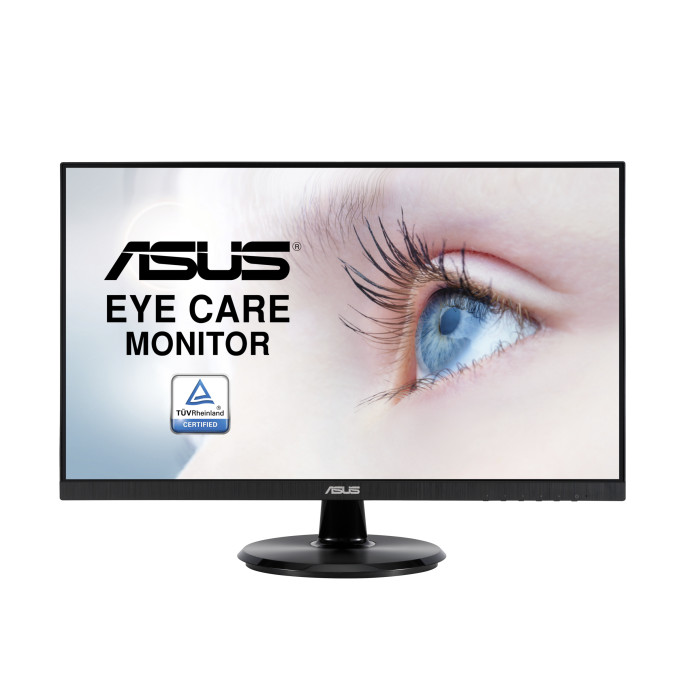







£184.99*
- Resolution 1920 x 1080 Full HD
- Diagonal 27"
- Panel type IPS
- Refresh Rate 75Hz



Product information
ASUS VA27DCP Eye Care Monitor - 68.58cm (27 inch), Full HD, IPS, Frameless, USB-C, 65W PD, 75Hz, Adaptive-Sync/FreeSync™, Low Blue Light, Flicker Free, compatible with wall mounts
- 68.58cm (27 inch) Full HD (1920x1080), LED-backlit IPS display with wide 178° viewing angle
- A refresh rate of up to 75Hz with Adaptive-Sync/FreeSync™ technology eliminates lagging effects and provides sharp, crystal-clear video playback
- USB-C supports DisplayPort signal transfer and 65W Power Delivery via a single cable.
- Compatible with VESA wall mounts for more desk space
- ASUS Eye-Care monitors feature TÜV Rheinland certified Flicker-Free and Low-Blue-Light technologies for extra comfortable use
First-class picture quality meets classically elegant design
The ASUS VA27DCP Eye Care Monitor features a 68.58cm (27-inch) IPS panel with Full HD resolution (1920x1080), a wide 178° viewing angle and realistic picture quality. The USB-C port supports the transfer of DisplayPort video signals and 65W Power Delivery for your devices via a single USB-C cable. A refresh rate of up to 75Hz with Adaptive Sync technology (FreeSync™) prevents lagging effects and ensures sharp, crystal-clear video playback. In addition, TÜV Rheinland certified Flicker-Free and Low-Blue-Light technologies are integrated for a particularly pleasant viewing experience.
Perfect image display from every angle
The IPS panel with a wide 178° viewing angle provides consistent, accurate colour reproduction from every angle to minimise colour shifts and provide a better viewing experience.
Frame-less design
Makes it perfect for near gapless multi-monitor configurations that offer an even higher level of immersion.
USB-C connectivity
USB-C connectivity allows you to connect a variety of different devices. The reversible USB-C connector makes connecting any type of device a breeze. USB-C supports the transfer of DisplayPort video signals and Power Delivery with up to 65W for your notebook or mobile devices via a single USB-C cable. (USB-C devices with DP Alt mode required).
Ultra-smooth visuals with Adaptive-Sync/FreeSync™
Adaptive-Sync/Freesync™ technology prevents tearing and compensates for fluctuating frame rates for smooth gameplay with seamless visuals. So you'll always have the upper hand, whether you're playing first-person shooters, racing games, real-time strategy or sports titles. (Adaptive-Sync/FreeSync™ works at refresh rates ranging from 48Hz to 75Hz).
Exclusive ASUS GamePlus Technology
With the customer in mind when it comes to design - the ASUS-exclusive GamePlus hotkey offers special in-game features such as a crosshair, timer, FPS indicator and screen alignment functions to help you get more out of your game. This feature has been developed in collaboration with professional gamers to help them practice and improve their gaming skills.
Exclusive ASUS Splendid Technology
By implementing some of our exclusive technologies, we have raised the bar quite a bit to provide users with a vibrant visual experience. Splendid Video Intelligence technology optimises picture quality and video playback by analysing the individual pixels of a full screen image. This allows brightness, contrast, image sharpness and colour reproduction to be optimally adjusted. In addition to Landscape, Standard, Game, Theatre, sRGB and Night modes, Splendid offers two new modes - Reading Mode and Dark Environment Mode. The Low Blue Light and Flicker Free technologies also reduce eye strain during prolonged use.
ASUS Blue Light Filter
The ASUS Blue Light Filter, certified by TÜV Rheinland, protects you from harmful blue light. The filter is conveniently accessible via the OSD menu and offers intuitive, flexible operation with infinite settings (0 to maximum)
ASUS monitors undergo particularly rigorous performance testing and are certified by TÜV Rheinland, a global provider of technical, safety and certification services.
Flicker-Free Technology
Tired and strained eyes are a thing of the past. ASUS monitors feature TÜV Rheinland certified ASUS Flicker-Free Technology to reduce screen flicker for an extra comfortable viewing experience. This prevents fatigue and other harmful effects that can be caused especially by watching videos on the screen for hours.
Technical data
| Name | Asus VA27DCP Eye Care Monitor 27 " IPS Monitor, 1920 x 1080 Full HD, 75 Hz, 5 ms |
|---|---|
| Article number | 1000024594 |
| GTIN/EAN | 4711081183624 |
| Manufacturer SKU | 90LM06H5-B01370 |
| EPREL ID | 465496 |
| Model name | VA27DCP Eye Care Monitor |
| Brand | Asus |
| Product Type | Monitor |
| Product Series | Asus VA Series |
| Technology | LCD |
| Panel type | IPS |
| Resolution | 1920 x 1080 Full HD |
| Diagonal | 27" |
| Aspect Ratio | 16:9 |
| Viewing angle - Horizontal | 178° |
| Viewing angle - Vertical | 178° |
| Contrast Ratio | 1,200 :1 |
| Max. Brightness | 250 cd/m² |
| Response time | 5ms |
| Refresh Rate | 75Hz |
| Support - VESA | 100 x 100 |
| Inputs | 1x HDMI , 1x USB-C |
| Features | Flicker Free , Integrated speaker |
| Product width | 61.2 cm |
| Product height | 36.5 cm |
| Product depth | 5.39 cm |
| Weight | 5 kg |
| Colour | Black |
| EEK Spectrum | A to G |
| Energy efficency class | D |
| Delivery contents | Power cable , USB-C Cable |
| Condition | New |
| Warranty | 24 Month |
| Warranty type | Bringin service Service and support information |
Downloads
Product safety
| Person responsible for the EU |
|---|
| Ninepoint GmbH |
| Im Mediapark 8 |
| 50670 Köln |
| Germany |
| info@asus-shop.de |



